Scrolling through Lisa’s Instagram, I was struck by photos of a meticulous, magazine-ready home — large windows illuminating a bright living room draped in geometric linens, unique tiles installed before a white brick fireplace and indoor plants bathing in the plentiful sunshine.
“Home projects bring me relaxation; it’s something that sparks joy,” said Lisa Galarza, the mind and hands behind the well-designed space that unfolds in her Instagram grid.
We spoke via Zoom, the white and grey walls flashing behind her as she walked through a hallway into her bedroom upstairs. A thoughtful black accent wall was behind her, affixed with framed art that echoed the intentional design of the rooms downstairs.
Lisa’s home reflects consideration, thoughtfulness, and, for better or worse, something she can control.
“I like things my way. I’m a school principal, so I’m very organized, checking boxes and making things happen,” Lisa said at the start of our conversation. “Fostering was all about learning to let go.”
At age seventeen, Lisa had to relinquish control when she became a teen mother. She was immersed in the reality of being accountable for another person and how that means losing a part of yourself. Lisa remembers finding out that childcare would cost $700 per month. “It might as well have been a million dollars” she said, thinking of her seventeen-year-old self.
Thankfully, she had her family.
Her mother was clear that she could live with them and they would provide childcare if she was pursuing her education. So, at eighteen, Lisa was a single-mom, attending community college-classes and trying to figure out a life path for herself. She vividly remembers listening to the wailing of her baby while pacing through the house. Unable to contain her own sobs, she called her mother for advice. “The only way I did it was through support,” she said. “I had a very supportive family.”
That’s one of the reasons that two decades later, after knowing each other for eight years and being married for six, Lisa and her husband Michael decided to foster.
“I wanted to be the support for someone else who might need it. The goal was to provide support and allow a family to reunify, I believe families should be together.” While Lisa felt called to foster, her husband Michael was hesitant at first.
“I was asking him for like a year, like ‘What do you think?’” Lisa said. “And he was like ‘No, I don’t know about that.’”
But Lisa finally convinced Michael to go to an information session. On folding chairs, beneath fluorescent lights, Michael and Lisa learned that some 250,000 children enter the United States foster care system each year. Michael, a number-oriented engineer, was struck.
Then a foster parent spoke.
“She had parented seven children, by herself,” Lisa said.
If she could do it, Michael felt they could—and should. “When we left the information session, he was just crying, he was like, ‘We have to do this,” she said.

That first month of their fostering journey, Lisa was elated. The three-year-old boy who had arrived in her home was wonderfully well-behaved, and she thought she was one of the lucky ones. To protect the boy’s privacy, we will be referring to him as Alexander in this article.
“I was talking to a coworker about how easy the transition was, and she mentioned something called the “honeymoon phase” I was like, ‘No, I’ve never heard of that, he’s just part of our family from day two…’” Lisa said.
Unfortunately, Alexander had experienced extreme loss, and his behavior with Lisa began to reflect that.
“Things started to shake up with his behavior.”
Alexander had been incredibly attached to his biological mother, so he was resistant and pushed boundaries with Lisa. “I was just a random person who had taken him out of his life,” Lisa said. His reports from school reflected a compassionate and caring student who was patient and willing to help his friends, but that was a side of Alexander that Lisa wouldn’t know for many months.
Alexander would become sad about his separation from his biological family. Since he didn’t know how to identify and handle his emotions, they would morph into rage.
One day, Lisa clicked Alexander into his car seat, and they headed off to IKEA. In the aisles, among every kitchen gadget you could ever need, beneath the glow of the ceiling lamp display, a tantrum unfolded.
“He was shouting, ‘You’re not my mom!’”
“He was shouting, ‘You’re not my mom!’”
Alexander had decided he didn’t want Lisa to touch him or the cart in which he was seated, so he was trying to push himself through the aisles between bouts of yelling if Lisa came too close.
“Of course, everyone in the store was looking,” said Lisa.
She tried to remain calm.
So, while Alexander attempted (unsuccessfully) to push himself around the store, Lisa watched to make sure he was safe, but otherwise left him alone.
“After about 30 minutes, he let me push him in the cart, but then he had a meltdown again at the checkout…It was really scary. I decided I should start carrying the paperwork that says I’m his guardian in case the police got involved at some point; things that you don’t normally think about when you’re just running to IKEA.”
Alexander’s tantrums were a common occurrence, and when they happened at home, the family developed a ritual — his dad would take him on a “boy walk” to get some air and give Lisa some space. For months, boy walks happened daily.
All the while, Lisa was never sure what a call from the state held. She never knew if the boy she was spending time loving and being patient with would be gone the next day.
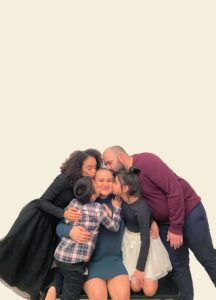
If you seek examples of love in classic literature and media, you have Hades, who traps Persephone in the underworld for the winter, Juliet, who endures the uncertainty of death rather than living without Romeo, and countless romantic comedies where the couple lives together, happily ever after. In the classic love stories of our time, a sense of ownership lurks around the edges. There’s a theme of being completed by another person and of knowing that they’ll always be there.
“Fostering goes against all the ideas we are taught about love,” Lisa said, “You have to love a person even though you know they might leave one day, and you will never see them again.”
Ask any foster parent about “getting too attached,” about the grief they’re in for when their child leaves, and you’ll see that this kind of love is a different practice.
This kind of love is about giving up control.
“Can I call you mom?”
Alexander was having daily meltdowns, and all Lisa she could do was be there for him while he felt his understandable pain. In their apartment, small, dark-haired Alexander would end up sobbing after an angry episode. “There were times when I would just cry with him, he would look at me and be like, ‘Why are you crying?/ and I would just be like, ‘Because it’s so sad, and it isn’t fair.”
For the first year that he was with them, Lisa took Alex to therapy every Tuesday night. One night after therapy, they drove home, the vibration of the road filling the car with soft white noise. “He was being so quiet, which is weird for him, he is usually very chatty,” Lisa said. She glanced in the rearview at Alex, deep in thought in the back seat.
“Lisa?” Alex said from behind her.
“Yes Alex?”
“How many days have I been with you?”
“Hmm, well, about six months, so something like 180 days.”
“And how long was I with my mom?”
“Three years, so maybe 1,000 days.”
“So I was more with my mom than you, right?
“Yes, you were bud.”
Alexander mulled this over, and then, in a small voice, asked, “Can I call you mom?”
Just like that, Alexander decided — he could trust Lisa.
“From that day forward the change in his behavior was unreal,” Lisa said.
One day a call came from the state asking if the family would consider adopting the boy. While Lisa’s goal with fostering had been helping a family towards reunification, Lisa and Mike decided to move forward with the process.
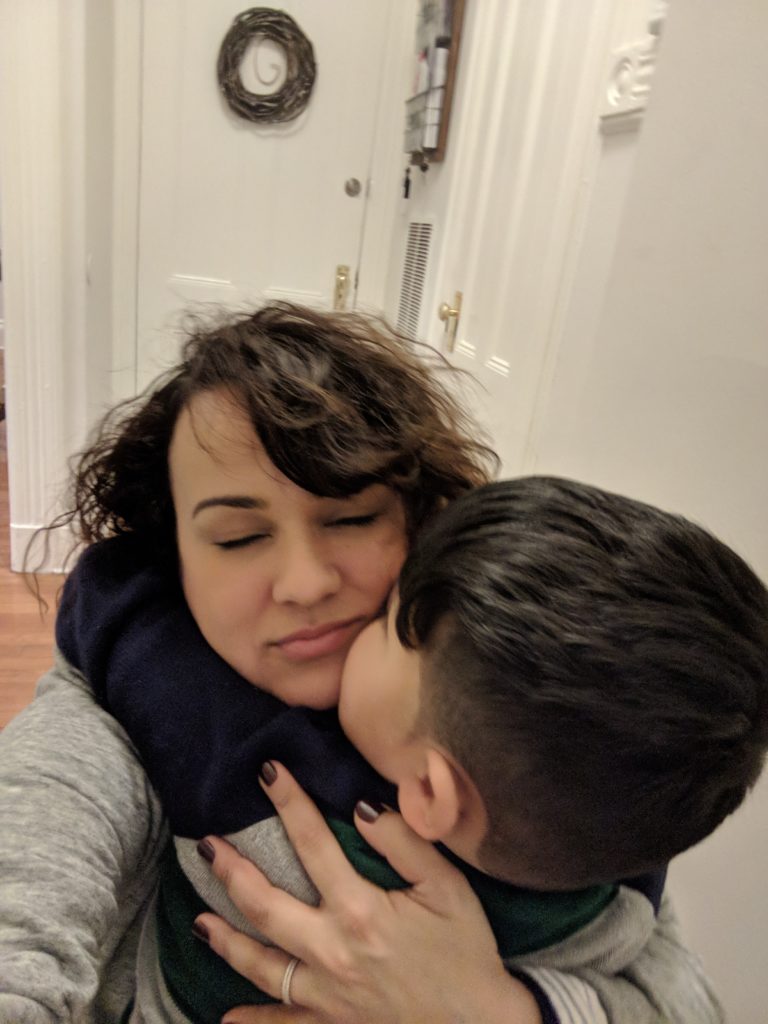
Not long after they were beginning the adoption process with Alexander, Lisa and Mike received a surprising phone call from the state. “Alexander had a sister in Florida who he hadn’t seen in a year and a half,” said Lisa. The state was asking if they’d bring her into their home.
It took about nine months, but Melissa, Alexander’s six-year-old sister, eventually joined the family. When the siblings reunited at the airport, there was an air of hesitance between them, even while they hugged. “Last time she saw him he was only a year-and a-half old,” said Lisa. “She was shocked that he was talking!”
The couple had to play catch-up with the kids’ health. They were behind on their vaccines, and they had to have surgeries and procedures, many of which involved their teeth. So when their biological parents gave them candy at visits, the couple was appalled.
“We were like “They can’t have candy at visits! They have bad teeth and they’ve had surgeries! Absolutely not. Who do we talk to about this?”
“[The social workers] would listen to us and hear us out, but at the end of the day it wasn’t what we thought was best for him that mattered…so that was really hard,” said Lisa.
Alexander’s toothy smile is another prominent part of Lisa’s Instagram feed. “Eventually though, we realized a bit of candy wasn’t the end of the world,” she said.
We seem to have control over a lot of things. But how true is that, really? We sit in traffic day after day, bound by the morning and evening rushes that dictate life for so many of us. We work, maybe because we love it, or maybe we need the money and health insurance. We must sleep and we must eat.
And now, a deadly pandemic has amplified the fact that we might not have as much control as we think. A virus has spread itself out over our world, creating carnage of economies, leaving people jobless and homeless.
Lisa and her family felt the difficulties of the pandemic. She was laid off when the shutdowns started in March. She quickly took over the role of homeschooling her kids, turning her dining room into a make-shift classroom with colorful educational posters on the wall (which certainly didn’t match her design scheme).
Two and a half years into fostering, she became foster mom and teacher without much say in the matter, like so many parents across the country.
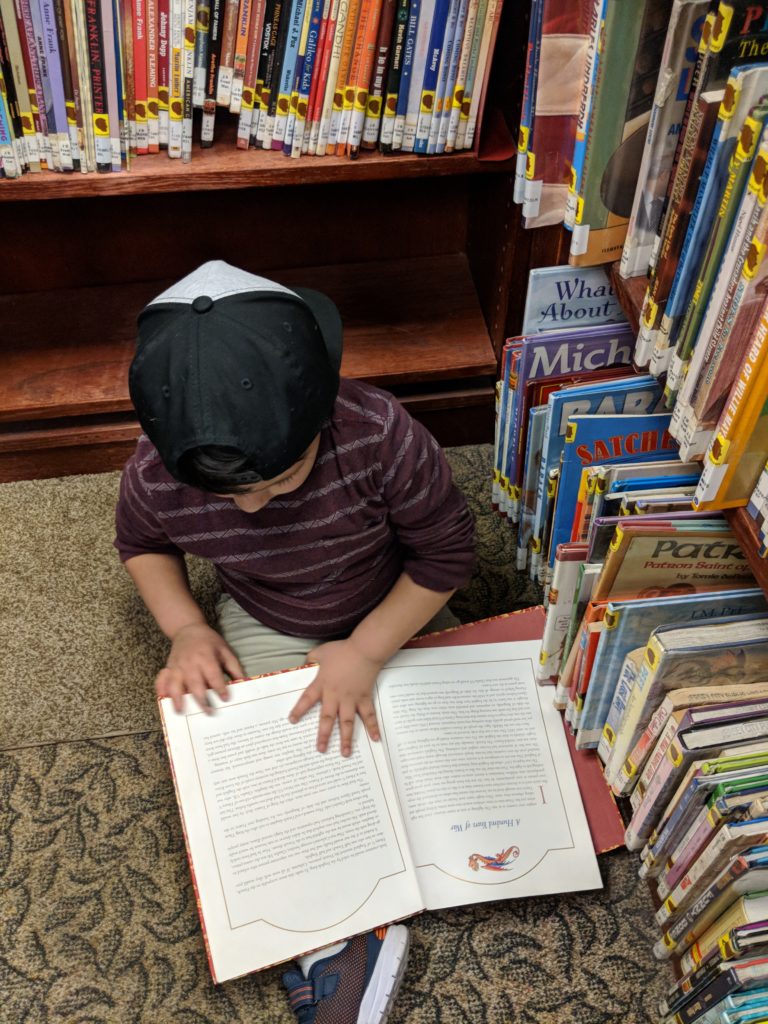
It takes some time, but if you scroll down in Lisa’s feed, you eventually get to the cancer photos.
Lisa draped in a hospital gown. Lisa, bald, holding up a peace sign.
A year-and-a-half into fostering, and more than a year since getting a call asking if she would consider adoption, Lisa was given the news that so many of us dread. She was diagnosed with breast cancer.
“When I was told the words ‘It’s cancer’ it was literally an out of body experience. My first reaction was laughter! I literally started laughing! I think it was some sort of shock reaction.” Lisa wrote in an Instagram post.
“The first thing I thought of was my children and how they would react…They were going through so much already.” Her diagnosis came right in the middle of hearings to terminate her foster children’s parental rights.
The first week, Lisa was in and out of sterile hospital rooms receiving scans and tests to determine the severity of her cancer. “That first week was the hardest,” she said. Having a diagnosis, however, shifted her attention and worry off fostering.
“With fostering you never know what a phone call is going to say, it could be that there is another sibling, or it could be a call saying they’re going to reunify,” Lisa said. When she was diagnosed, she had to let go of control surrounding her children’s futures.
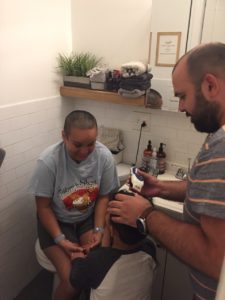
What do people mean when they say to “let go of control” though, really? We can’t just “let go” of the bills, and dinner isn’t going to make itself. Maybe control has more to do with how we think of things in our psychic world than what we must do to survive in the physical world.
Lisa had no choice over the fact that she was going to lose her hair during chemotherapy. “Instead of having my hair fall out, I decided to shave my head right away,” she said.
When going through a crisis, many people take control of one thing they can, their hair. Hair is integral to people’s conceptions of themselves. Maybe they dye it or brush off their family’s advice and cut their own bangs. Whatever it is, it’s satisfying to have control over something, even if it’s just your uneven bangs that you run to the salon to have touched-up by a professional.
“[My son] was really worried when we told him about losing my hair,” Lisa said, her now short curls held back by a headband. She and her husband had pulled out the buzzer in their bathroom, tufts of dark, curly hair cluttering the floor as her pale scalp was left bare.
To her surprise, her four-year-old walked in and announced that he wanted to shave his head too. “When he saw me, he was like “That’s so cool! I want to do it!” She said, grinning. “He insisted on it, he said, ‘Mom I have to shave it bald. We have to be bald together!’”
“We just worried so much and it was so stressful in the beginning. And then my diagnosis of cancer really shifted things, like we can’t stress about everything. All we can do is take one day at a time.”
Lisa said something clicked for her son when she was going through chemotherapy. “He was on his best behavior.” Lisa said. Her family joined to support her, taking advantage of the days when she felt well enough to spend time with them. “They realized they needed to take care of me,” she said. Lisa and her husband explained cancer as the bad guy, and when she would leave for chemo, her kids waved her off, telling her to “Go beat up that cancer!”
Something shifted for Lisa, too.
“We just worried so much and it was so stressful in the beginning. And then my diagnosis of cancer really shifted things, like we can’t stress about everything. All we can do is take one day at a time…”
She emphasized that with cancer, she was comforted by the fact that there was an agenda, “At least with cancer there was a treatment plan. I had a schedule. I knew when I was going to chemotherapy.” With fostering, Lisa never knew what the call from DCP&P would say, how a court hearing would go, whether the son she’s had in her house for three years would be gone after one phone call.
If we are aware, there are certain things we can control. We get to choose to make time to exercise, what types of food we eat, what television shows we watch and with whom we spend our time. We buy clothes that represent our sense of self. Lisa chose to follow her cancer treatment plan. She chose to foster. She chose to decorate her house as stress relief.
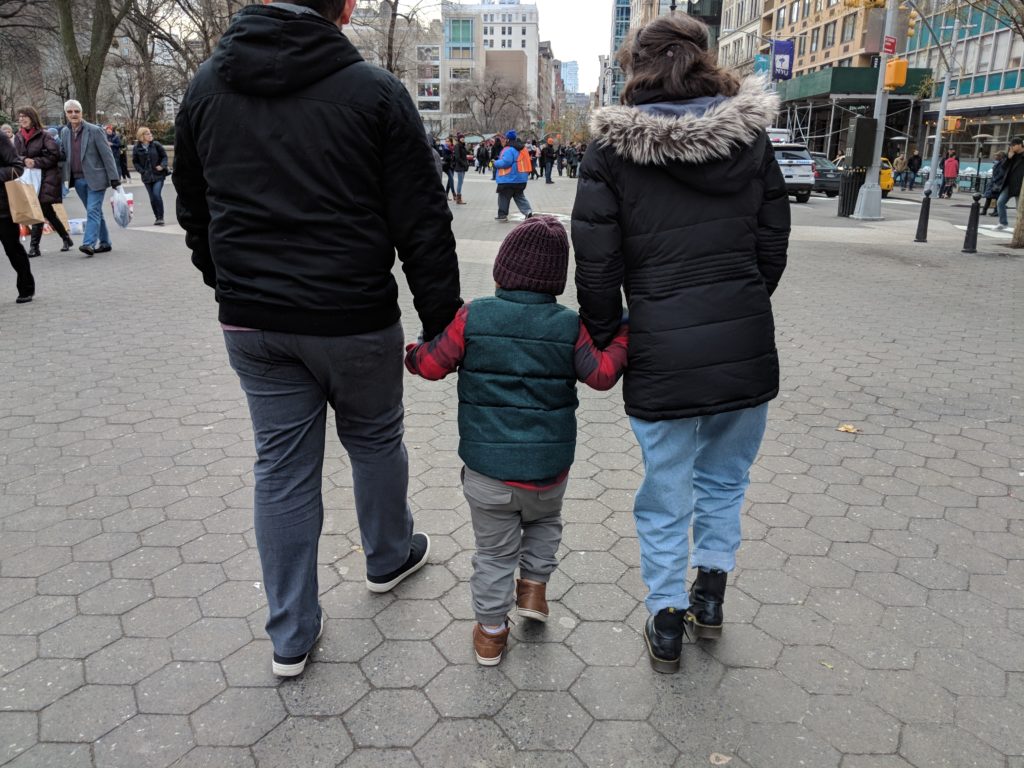
Now cancer-free, Lisa is growing out her beautiful curls and she and her husband surprised the kids by moving into a house.
In three years, Lisa and her husband went from empty nesters to a house filled with the squeals of two young children. The couple adopted Melissa, but things with Alex remain up in the air. As foster parents know too well, the process can take much longer than anticipated.
The family has handled a cancer diagnosis, treatment and remission, home schooling, moving, and, just to add to the excitement, an adorable puppy.
Since moving to their new home a few months ago, Alex has only had to take two boy walks with his dad.
It’s been an incredible journey of change and letting go, and it sounds like Lisa wouldn’t have it any other way. As she said in an Instagram post, “…the beauty in this story is that I have become a better version of the woman I was. A woman who sees life differently. I used to stress about the silliest things. Now the mundane parts of life are my favorite! Slow down. Be still.”



I am really interested to be a foster mom.
So proud of my daughter and grandkids. Love ❤️ you guys.